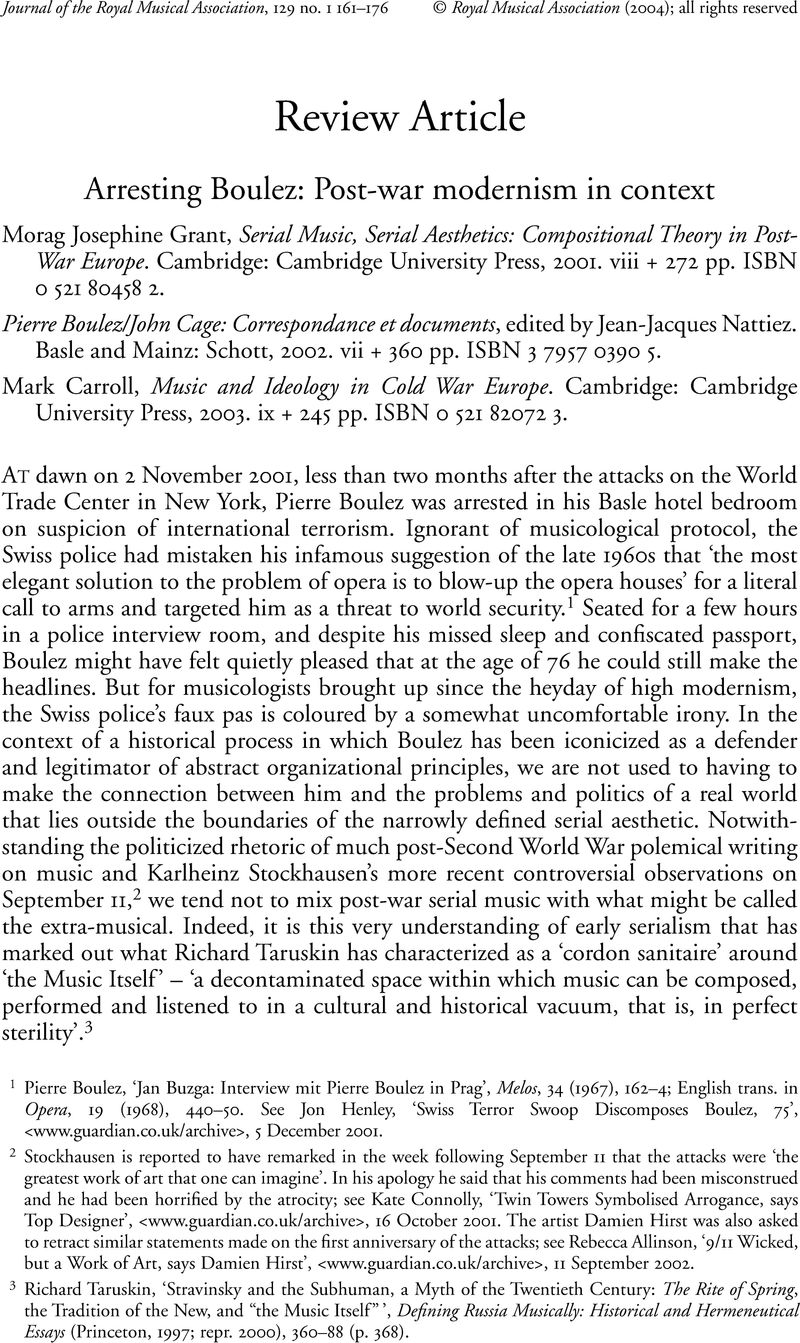No CrossRef data available.
Article contents
Arresting Boulez: Post-War Modernism in Context - Josephine Morag Grant, Serial Music, Serial Aesthetics: Compositional Theory in Post-War Europe. Cambridge: Cambridge University Press, 2001. viii + 272 pp. ISBN 0 521 80458 2. - Pierre Boulez/John Cage: Correspondance et documents, edited by Nattiez Jean-Jacques. Basle and Mainz: Schott, 2002. vii + 360 pp. ISBN 3 7957 0390 5. - Carroll Mark, Music and Ideology in Cold War Europe. Cambridge: Cambridge University Press, 2003. ix + 245 pp. ISBN 0 521 82072 3.
Published online by Cambridge University Press: 01 January 2020
Abstract

- Type
- Book Review
- Information
- Copyright
- Copyright © Royal Musical Association, 2004
References
1 Pierre Boulez, ‘Jan Buzga: Interview mit Pierre Boulez in Prag’, Melos, 34 (1967), 162–4; English trans. in Opera, 19 (1968), 440–50. See Henley, Jon, ‘Swiss Terror Swoop Discomposes Boulez, 75‘, <www.guardian.co.uk/archive>, 5 December 2001.Google Scholar
2 Stockhausen is reported to have remarked in the week following September 11 that the attacks were ‘the greatest work of art that one can imagine’. In his apology he said that his comments had been misconstrued and he had been horrified by the atrocity; see Connolly, Kate, ‘Twin Towers Symbolised Arrogance, says Top Designer’, <www.guardian.co.uk/archive>, 16 October 2001. The artist Damien Hirst was also asked to retract similar statements made on the first anniversary of the attacks; see Allinson, Rebecca, ‘9/11 Wicked, but a Work of Art, says Damien Hirst’, <www.guardian.co.uk/archive>, 11 September 2002.,+16+October+2001.+The+artist+Damien+Hirst+was+also+asked+to+retract+similar+statements+made+on+the+first+anniversary+of+the+attacks;+see+Allinson,+Rebecca,+‘9/11+Wicked,+but+a+Work+of+Art,+says+Damien+Hirst’,+
3 Richard Taruskin, ‘Stravinsky and the Subhuman, a Myth of the Twentieth Century: The Rite of Spring, the Tradition of the New, and “the Music Itself”‘, Defining Russia Musically: Historical and Hermeneutical Essays (Princeton, 1997; repr. 2000), 360–88 (p. 368).Google Scholar
4 Gary Tomlinson, ‘Musical Pasts and Postmodern Musicologies: A Response to Lawrence Kramer’, Current Musicology, 53 (1994), 18–24 (p. 22).Google Scholar
5 Taruskin, ‘Stravinsky and the Subhuman’, 374.Google Scholar
6 Susan McClary, ‘Terminal Prestige: The Case of Avant-Garde Music Composition’, Cultural Critique, 12 (1989), 57–81 (p. 66).Google Scholar
7 Georgina Born and David Hesmondhalgh, ‘Introduction: On Difference, Representation, and Appropriation in Music’, Western Music and its Others (Berkeley and Los Angeles, 2000), 1–58 (p. 5).Google Scholar
8 György Ligeti, ‘Pierre Boulez: Entscheidung und Automatik in der Structure Ia’, Die Reihe, 4 (1958), 38–63; trans. Leo Black as ‘Pierre Boulez: Decision and Automatism in Structure 1a’, Die Reihe, 4 (1960), 36–62 (p. 36).Google Scholar
9 Ligeti, ‘Pierre Boulez: Decision and Automatism’, 41.Google Scholar
10 McClary, ‘Terminal Prestige’, 61.Google Scholar
11 See especially his introduction to Pierre Boulez, Stocktakings from an Apprenticeship, trans. Stephen Walsh (Oxford, 1991), xiii–xxix.Google Scholar
12 Robert Piencikowski, ‘… iacta est.‘, Boulez/Cage Correspondance, ed. Nattiez, 13–39 (in French), 41–60 (in English; p. 43).Google Scholar
13 For publication history, see ibid., 41.Google Scholar
14 Ibid., 58.Google Scholar
15 Pierre Boulez, ‘Aléa’, La nouvelle revue française, 59 (1957), 839–57.Google Scholar
16 Piencikowski's discussion of Boulez's damning comparison of Cage and Satie is fascinating: ‘Cage lurks behind the figure of Satie in Boulez's writings’, Piencikowski argues. Boulez wrote in a letter to Robert Craft in 1957 that each was ‘dogged by the emptiness of his own writing … [each] takes refuge, as always, in “innocence”'. Piencikowski, ‘… iacta est.’, 44–7.Google Scholar
17 Piencikowski, ‘… iacta est.‘, 52.Google Scholar
18 Susan McClary, Conventional Wisdom (Berkeley and Los Angeles, 2001), 136.Google Scholar
19 See especially Boulez's defence against postmodern critique in Michel Foucault and Pierre Boulez, ‘Contemporary Music and the Public’, trans. John Rahn, Perspectives of New Music, 23 (1985), 6–12.Google Scholar
20 See Tom Wicker et al., ‘CIA Spies from 100 Miles Up’, New York Times (27 April 1966), 28.Google Scholar
21 Hans Werner Henze, Music and Politics: Collected Writings 1953–81, trans. Peter Labanyi (London, 1982), 49.Google Scholar
22 Joseph Kerman, Contemplating Music (Cambridge, MA, 1985), 101.Google Scholar
23 Pierre Boulez, ‘Possibly …’, Stocktakings, 111–40 (p. 113); first published as ‘Éventuellement …’, La revue musicale, 212 (1952), 117–48.Google Scholar
24 Pierre Boulez, ‘Current Investigations’, Stocktakings, 15–19 (p. 19); first published as ‘Recherches maintenant’, La nouvelle revue française, 23 (1954), 898–903.Google Scholar
25 Simone de Beauvoir, Force of Circumstance (London, 1965), 455.Google Scholar
26 McClary, ‘Terminal Prestige’, 66.Google Scholar
27 Piencikowski, ‘… iacta est.‘, 42.Google Scholar




